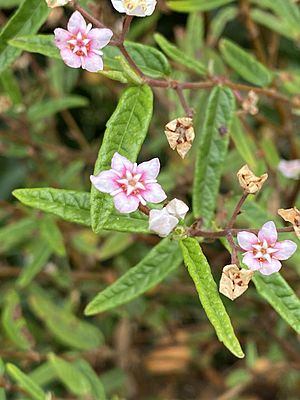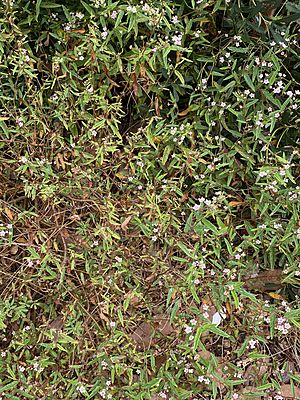Commersonia amystia facts for kids
Quick facts for kids Commersonia amystia |
|
|---|---|
 |
|
| Cultivated specimen in Bundanoon | |
| Scientific classification | |
| Genus: |
Commersonia
|
| Species: |
amystia
|
Commersonia amystia is a special kind of flowering plant found only in eastern Australia. It's a small, low-growing bush. Its leaves are shaped like narrow eggs and are covered with tiny, star-shaped hairs, especially on the underside. The flowers have five white, petal-like parts called sepals, which often turn pink as they get older. They also have five smaller white petals.
Contents
About the Commersonia amystia Plant
Commersonia amystia is a small bush that usually grows only about 10 to 30 centimeters (4 to 12 inches) tall. Its branches are covered in many tiny hairs.
When the plant is young, its leaves have three rounded parts. These young leaves can be up to 5.3 centimeters (2 inches) long and 3.1 centimeters (1.2 inches) wide. They have small, saw-like edges.
As the plant gets older, its leaves become narrow and egg-shaped. They are usually between 2.5 and 32 millimeters (0.1 to 1.3 inches) long and 1.5 to 9.2 millimeters (0.06 to 0.4 inches) wide. Each leaf has a short stalk, called a petiole, which is about 0.8 to 2.5 millimeters long. These leaves are covered with white, star-shaped hairs, especially on their undersides. Their edges can be wavy or have irregular teeth.
The flowers usually grow in small groups of two to four. Each group grows on a hairy stalk called a peduncle, which is 2.5 to 18 millimeters long. The individual flowers are on shorter, hairy stalks called pedicels, about 2 to 8.5 millimeters long.
Each flower has five white parts that look like petals, called sepals. They are 3.9 to 5.8 millimeters long and sometimes have a pink color near their base. Inside, there are five white, cup-shaped petals, about 2 to 3 millimeters long and wide. These petals are red near their base and have a small, white flap called a ligule at their tip. Five white staminodes (parts that look like stamens but don't produce pollen) surround the central part of the flower.
Commersonia amystia flowers mostly from August to October. After flowering, it produces a fruit called a capsule. This capsule is about 8 to 10 millimeters long and 11.5 to 13 millimeters wide. It's covered with soft white hairs and bristles.
How Commersonia amystia Got Its Name
The plant Commersonia amystia was officially named in 2008 by two scientists, Carolyn F. Wilkins and Lachlan Mackenzie Copeland. They wrote about it in a science journal called Telopea.
The second part of its name, amystia, comes from a word that means "large cup." This refers to the cup-like shape at the base of the plant's petals.
Where Commersonia amystia Lives
This type of commersonia plant grows in rocky cracks in open forests. You can find it in a few places in Australia. It lives near Inverell in New South Wales and in the Ballandean-Stanthorpe area in Queensland.
Life Cycle of Commersonia amystia
Scientists have observed that Commersonia amystia plants seem to die when there's a bushfire. However, after a fire, many new seeds sprout and grow. These new plants then seem to get old and die off after a few years.
Images for kids



